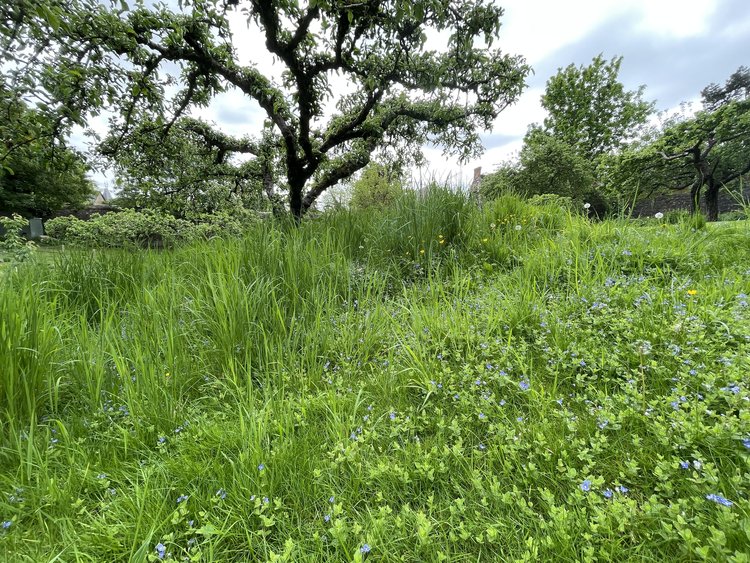How green are the Cathedral Gardens?
/
How green are the Cathedral Gardens?
May 5, 2022
In their duty to care and maintain the Gardens the Cathedral Gardeners employ a range of conservation practices to keep the gardens a key part of the biodiversity of Rochester.
Biodiversity is a central aim of conservation. Effective garden management seeks to maintain and boost the insects, plantlife and animals of the area. The gardens range from the highly manicured Cloister Garth on the south side of the Cathedral, to the more meadowlike (although no less managed) King's Orchard. Simple but effective techniques and choices help to boost biodiversity in all these areas.
Records survive of directions to mow the Cloister Garth in the Middle Ages. Today this space and the surrounding banks are maintained as lawns providing continuity to this 900-year heritage. The lawns are maintained at different heights to boost the species of plants and insects that can thrive in them. Leaving grass higher in July, for example, leaves space for clover. Banks around the cloisters are left to grow high to provide space for spring daffodils and summer flowers. At its highest, areas of grass in King's Orchard are left uncut for wildflower meadows.
Two bee hives have been established in the last three years. Bees are perhaps the most important of all insects in their role as pollinators, fertilising plants as they move from flower to flower, but boosting habitats for other insects is an important element of improving biodiversity in any area. Insects improve the soil, pollinate flowering plants, and provide food for birds and small animals.
Hardwood logs and brush is strategically piled around King's Orchard. As these piles rots, they provide habitats for insects to overwinter, such as the stag beetles that are known in the area, and also smaller animals such as voles and mice.
Four bug hotels were installed last year in the vicinity of the vineyard.
Key species of plants are provided that provide a place for spiders to overwinter. Cow parsley has been planted, an early source of nectar for pollinators and beneficial insects. Stinging nettles are managed in the meadow of King's Orchard as a key plant species for caterpillars.
A pond was installed in King's Orchard this year, which will further boost insect life, and particularly dragonflies.
A bird survey is regularly conducted to gauge the success of all this bug collecting. Over 26 species of bird have been identified on the site over the past few years, including thrushes, chiffchaffs, goldcrests, blackcaps and a rare grey wagtail nesting on the Cathedral itself. Starlings regularly nest in the gigantic sweet chestnut tree in King's Orchard which is over 250 years old.
Aside from the benefits of the gardens to the local environment, steps are taken to decrease the consumption in their care and maintenance. Eco fuel is used for mowers and strimmers burning cleaner than petrol or diesel, releasing fewer harmful fumes and also lessening wear on the motors. The majority of other equipment used by the gardeners is electric.
Rainwater is harvested from the roofs of the gardeners compound for use in the gardens. Use of sprinklers and other consumption-intensive irrigation techniques is avoided.
Care is taken over the use of herbicides and pesticides and use in general is minimalised. Herbicides are used several times a year on the pavements and pathways around the site. No pesticides are used in the care of the roses around the cloisters and Old Deanery gardens. The boxes of the Knot Garden are sprayed for box blight and moth.
Soft green waste from the gardens and the Cathedral flower arrangers is composted on site. Burning is restricted to the traditional King’s School bonfire night. Softwood is chipped and reused as mulch on the garden borders, helping to reduce water loss and improving soil quality over time. Leaves are collected and used for leaf mould; an excellent soil conditioner.
The activities of the Gardeners plays a key role in maintaining and improving biodiversity in the area, ensuring these spaces serve to their full potential in enhancing the Cathedral Precinct and wider Rochester.
Jacob Scott in discussion with Graham Huckstepp, Head Gardener
Find out what we are doing to minimise the impact on the environment of the activities in and around the Cathedral in Running Rochester Cathedral
Find out more about the sustainability projects at Rochester Cathedral, recipient of the ROCHA Silver Eco Church Award.
Explore the history and archaeology of the Priory of Saint Andrew and find out more about green heritage at Rochester Cathedral.












